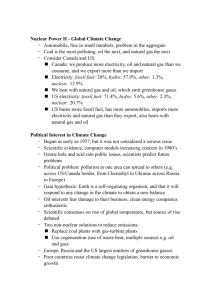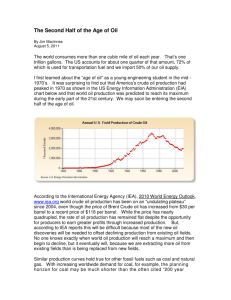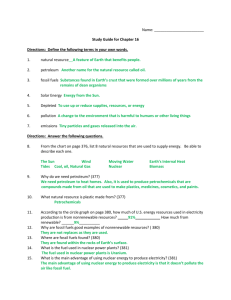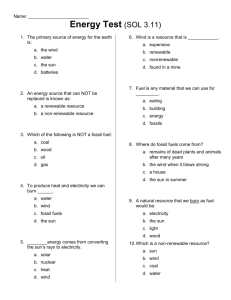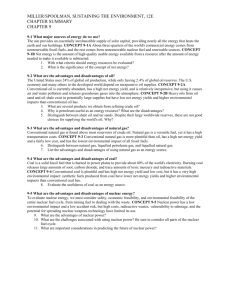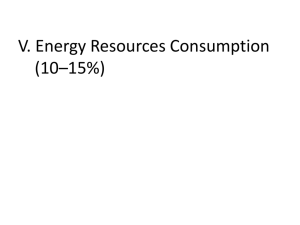Radioactive Waste
advertisement
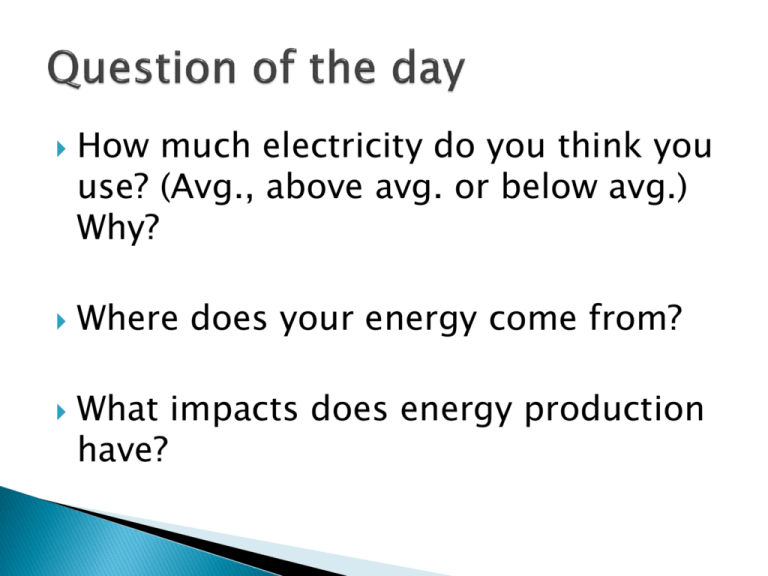
How much electricity do you think you use? (Avg., above avg. or below avg.) Why? Where does your energy come from? What impacts does energy production have? http://www.worldpopulationbalance.org/pop /energy/ Though accounting for only 5 percent of the world's population, Americans consume 26 percent of the world's energy. (American Almanac) In 1997, U.S. residents consumed an average of 12,133 kilowatt-hours of electricity each, almost nine times greater than the average for the rest of the world. (Grist Magazine) 60% 50% Coal 56% Nuclear 37% Natural gas 3.3% Petroleum 1.3% Renewables 1.3% Hydro <1% 40% 30% 20% 10% 0% Energy Source Efficiency: A conventional coal generation facility is about 40% efficient, which means that 60% of the energy is lost before leaving the plant. Our School: By the time electricity gets to your school, nearly 2/3 of the energy is lost. Keep in mind, that most schools in PA could stand to improve energy efficiency by 30%. Transmission & Distribution: In the U.S. approximately 7% of electricity is lost moving electricity through the wires to your home or schools o Energy consumption in the US • • Industries (production) use the most Heating, cooling, and illuminating building is 1/3 How do fossil fuels form? List three fossil fuels. Where are there abundant resources of fossil fuels? (Region or countries) Combustible deposits in the Earth’s crust ◦ Composed of the remnants (fossils) of prehistoric organisms that existed millions of years ago ◦ Includes coal, oil (petroleum) and natural gas Non-renewable resource ◦ Fossil fuels are created too slowly to replace the reserves we use 300 million years ago ◦ Climate was mild ◦ Vast swamps covered much of the land ◦ Dead plant material decayed slowly in the swamp environment Over time, layers of sediment accumulated over the dead plant material Coal ◦ Heat, pressure and time turned the plant material into carbon-rich rock (coal) Oil ◦ Sediment deposited over microscopic plants ◦ Heat pressure and time turned them into hydrocarbons (oil) Natural Gas ◦ Formed the same way as oil, but at temperatures higher than 100 °C Coal is America’s most abundant fossil fuel and we have an estimated 250 year supply. America produces about 1 billion tons of coal each year -- 90% is used for electricity generation. Coal generated electricity provides 51% of all electricity in America. America’s electricity demand is expected to increase 36% by 2020 Statistics from www.learnaboutcoal.org PA Geologic Survey Map Worlds largest oil reserves: Country Millions of Barrels Percent World Reserve Saudi Arabia 259,400 21.83% Iran 125,800 10.59% Iraq 115,000 9.68% Kuwait 99,000 8.33% Venezuela 77,800 6.55% United Arab Emirates 55,210 4.65% Rest of World 456,090 38.37 Chart edited from www.factsonfuel.org 2004 Crude Oil Consumption by Region. 26% 25% USA Asia Pacific Western Europe Rest of World 19% 30% Edited from, Source: BP Statistical Review of World Energy, June 2005 Brainstorm 5 ideas with a partner 1. Combustion of fossil fuels creates air pollution 2. Excess CO2 gas released to atmosphere 3. Increase global climate- due to increase of greenhouse gases 4. Melting of the polar ice caps, rise in sea level due to climate change 5. Coal- acid mine drainage, ash etc. 6. Acid deposition- acid rain from sulfur and nitrogen compounds released when burned From Union of Concerned Scientists http://www.ucsusa.org/ From Union of Concerned Scientists http://www.ucsusa.org/ Coal plants produce one-third of America’s CO2 emissions—about the same amount as all our cars, SUVs, trucks, buses, planes, ships, and trains combined. A 500-megawatt (MW) plant produces the annual global warming emission equivalent of roughly 600,000 cars, but operates on average for 40 to 50 years(or longer). Statistics from Union of Concerned Scientists “Gambling with Coal” In 2005, Pennsylvania coal-fired power plants pumped almost 120 million tons of carbon dioxide, more than 985,000 tons of sulfur dioxide and more than 171,000 tons of nitrogen oxide into our air. Over the last several decades, this noxious mix of pollutants has seared Pennsylvania forests with the nation's highest levels of acid rain.… On the ridges of the Allegheny National Forest… 30 to 40 percent of the trees on some slopes are dead or dying… PennFuture Facts, Vol. 8, No. 20 -- October 4, 2006 Scrubbers Fluidized Bed Combustion (below) Annual world oil consumption has been exceeding additions for a long time. Most experts are predicting that oil production will peak in the next 5-10 years. Prices will continue to increase due to costs of extraction and transportation Proposed federal laws limiting global warming (also see Northeast Regional Greenhouse Gas Initiative http://www.rggi.org/) In PA, electric rate caps are being removed by 2010. School Districts pay energy bills out of the same budget which pays salaries, books, supplies, etc. Increases in fuel cost must = decrease other budget items (or increases in taxes) The least efficient schools use 3 times as much energy as the best performers. What do you know of the current Nuclear crisis in Japan? How about any past nuclear issues? Is nuclear power safe? Why or why not? Japan update http://www.cnn.com/ What is it? ◦Splitting of uranium atoms in a “reactor” to release energy to create heat to make steam to make electricity Nuclear Fuel Cycle ◦ processes involved in producing the fuel used in nuclear reactors and in disposing of radioactive (nuclear) wastes Pros ◦ No air pollution ◦ Small amounts of fuel = large amounts of energy ◦ U.S. has technology Cons ◦ Expensive to build and maintain Nuclear power plant ◦ Radioactive fuel, dangerous waste to dispose of Meltdown ◦ At high temperatures the metal encasing the uranium fuel can melt, releasing radiation Probability of meltdown or other accident is low Public perception is that nuclear power is not safe Sites of major accidents: ◦ Three Mile Island ◦ Chornobyl (Ukraine) 1979- most serious reactor accident in US 50% meltdown of reactor core ◦ Containment building kept radiation from escaping ◦ No substantial environmental damage ◦ No human casualties Elevated public apprehension of nuclear energy ◦ Led to cancellation of many new plants in US 1986- worst accident in history 1 or 2 explosions destroyed the nuclear reactor ◦ Large amounts of radiation escaped into atmosphere Spread across large portions of Europe Radiation spread was unpredictable Radiation fallout was dumped unevenly Death toll is 10,000100,000 Phila Inq. ArticleVisiting Chernobyl Life after people series on History Channel http://www.youtube.co m/watch?v=A62au7Av q1E&safety_mode=true &persist_safety_mode= 1 Three Mile Island Pgs. 464-468 questions 1-13. Low-level radioactive waste- High-level radioactive waste- ◦ Radioactive solids, liquids, or gasses that give off small amounts of ionizing radiation ◦ Radioactive solids, liquids, or gasses that give off large amounts of ionizing radiation Long term solution to waste ◦ Deep geologic burial –Yucca Mountain ◦ As of 2004, site must meet EPA million year standard (compared to previous 10,000 year standard) ◦ Possibilities: Above ground mausoleums Arctic ice sheets Beneath ocean floor Temporary storage solutions ◦ In nuclear plant facility (require high security) Under water storage Above ground concrete and steel casks Need approved permanent options soon. 70,000 tons of highlevel radioactive waste Tectonic issues have been identified Pros Safer than fission No air pollution Renewable energy Cons Technology very difficult Requires unrealistic high temp, pressure and concentration Biofuel – Any fuel derived from recently-living biomass ◦ ◦ ◦ ◦ ◦ ◦ ◦ Corn/grains Soybeans Wood (forestry residue, mill waste, C&D waste) Sugarcane Switchgrass Food waste Algae Ethanol ◦ Starches (corn) ◦ Cellulosic materials Biodiesel ◦ Waste vegetable oils/greases ◦ Soybean oil ◦ Canola Pros ◦ Renewable ◦ Good use of “waste” ◦ Ethanol less polluting than gas Cons ◦ Does produce CO2 (global warming) and smoke ◦ More grain for ethanol, less for food

